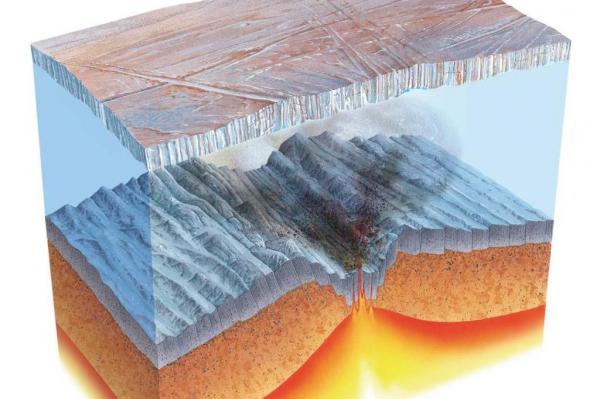
SOUTHAMPTON, England, Jan. 19 (UPI) — Researchers say underwater volcanoes are responsible for ending one of Earth’s most intense ice ages, known as “Snowball Earth.”
Between 720 to 640 million years ago, Earth was almost entirely ice. Climatic interactions and cycles among ocean, continent and atmosphere slowed to a halt.
But rather quickly, Earth transitioned from a freezer to a greenhouse. Researchers say it was a dramatic altering of ocean chemistry that precipitated the shift.
Previous research suggests changing ocean chemistry caused Snowball Earth. As the ancient supercontinent called Rodinia broke apart, river runoffs flooded the planet’s oceans with significant concentrations of minerals. The changing chemistry caused Earth’s ocean to suck up large amounts of CO2, plunging the planet into a severe ice age.
Earth’s new icy lid ended the geochemical influence of land and air. The ocean’s chief chemical catalyst shifted downward to the ocean floor, where large systems of underwater volcanos could be found spewing molten rock onto marine ridges.
“When volcanic material is deposited in the oceans it undergoes very rapid and profound chemical alteration that impacts the biogeochemistry of the oceans,” Thomas Gernon, Earth sciences professor at the University of Southampton, said in a press release. “We find that many geological and geochemical phenomena associated with Snowball Earth are consistent with extensive submarine volcanism along shallow mid-ocean ridges.”
Gernon is the lead author of a new paper on the subject, published this week in the journal Nature Geoscience.
Earlier studies have suggested the CO2 of ocean volcanoes eventually helped warm the atmosphere and melt the planet’s icy shell. The new research confirms this theory, but also explains the puzzling presence of thick mid-ocean ridge mineral deposits known as “cap carbonates.”
The break-up of Rodinia enabled Snowball Earth, but it also created intense volcanic ridges. Gernon and his colleagues say these volcanoes spewed large amounts of lava into the ocean, which quickly cooled to form a type of glassy pyroclastic rock called hyaloclastite.
According to researchers, these quickly thickening deposits leached large amounts of calcium, magnesium and phosphorus into the ocean.
“We calculated that, over the course of a Snowball glaciation, this chemical build-up is sufficient to explain the thick cap carbonates formed at the end of the Snowball event,” Gernon said.
The volcanoes may have even jump-started the evolution of early life forms, and kicked off the oxygenation of the planet.
“This process also helps explain the unusually high oceanic phosphorus levels, thought to be the catalyst for the origin of animal life on Earth,” Gernon concluded.





